by Amineddoleh & Associates LLC | May 3, 2018 |
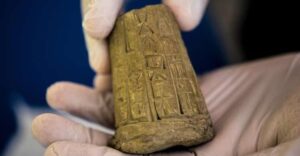
Photo courtesy of U.S. Immigration and Customs Enforcement (ICE)
Our founder, Leila A. Amineddoleh, served as a cultural heritage law expert for the Eastern District of New York in its case against Hobby Lobby. The national retail chain, Hobby Lobby, purchased over 5,500 ancient artifacts from dealers in the Middle East, after one of the world’s legal heritage experts, Patty Gerstenblith, warned the company about acquiring objects lacking clear provenance. She warned the company that classes of objects from Iraq (including cuneiform tables) have a high probability of being looted from archaeological sites. Ignoring the advice, the company moved forward with the purchases anyway, and the plundered artifacts (bearing shipping labels with falsified information) entered the US illegally.
Yesterday, nearly 4,000 of the pieces were returned to Iraqi officials at the embassy. These objects will most likely be displayed at Iraq’s National Museum.
Our firm is honored to have played a role in such a momentous repatriation. For more information about the case, please read one of our prior blog posts.
by Amineddoleh & Associates LLC | Dec 15, 2017 |
 Today Amineddoleh & Associates was honored to attend the repatriation ceremony for three looted antiquities from the Temple of Eshmun in Sidon, Lebanon. Our founding partner served as the cultural heritage legal expert for the District Attorney’s Office, providing expertise on Lebanon’s cultural heritage laws for the seizure of a marble sculpture formerly on loan to the Metropolitan Museum of Art.
Today Amineddoleh & Associates was honored to attend the repatriation ceremony for three looted antiquities from the Temple of Eshmun in Sidon, Lebanon. Our founding partner served as the cultural heritage legal expert for the District Attorney’s Office, providing expertise on Lebanon’s cultural heritage laws for the seizure of a marble sculpture formerly on loan to the Metropolitan Museum of Art.
During the ceremony, in which the items were returned to the Lebanese Republic, District Attorney Cyrus Vance addressed the need to protect against looting of art. He discussed the importance of due diligence by museums, auction houses, and collectors. He also acknowledged the work of Matthew Bogdanos, Karin Orenstein, and John Labatt. Homeland Security Investigations (HSI) Agent Erik Rosenblatt noted the link between organized terror and antiquities looting, mentioning the mounting evidence gathered by HSI. The Lebanese General Consul, Majdi Ramadan, expressed his gratitude for today’s repatriations, and the continued cooperation of the District Attorney’s Office and his nation. And finally, Irina Bokova, Director General of UNESCO, briefly spoke about the significance of the repatriated pieces and the importance of enforcing laws against looting. She applauded restitution ceremonies and legal action against looting as they signal the law enforcement agency’s willingness to pursue restitution and punish wrongdoing.
After the statements, Matthew Bogdanos, the attorney responsible for working on these repatriations, fielded questions from reporters. He noted that the antiquities were looted during times of conflict. He also clarified that the Metropolitan Museum of Art was not guilty of any wrongdoing, and that his team will continue working to restitute stolen and looted heritage.
It was an honor for Amineddoleh & Associates to play a role in the return of these items. For more information, please visit http://newyork.cbslocal.com/2017/12/15/ancient-sculptures-returned-to-lebanon/ and http://manhattanda.org/press-release/manhattan-district-attorney%E2%80%99s-office-returns-three-ancient-statues-lebanese-republic
by Amineddoleh & Associates LLC | Oct 12, 2017 |
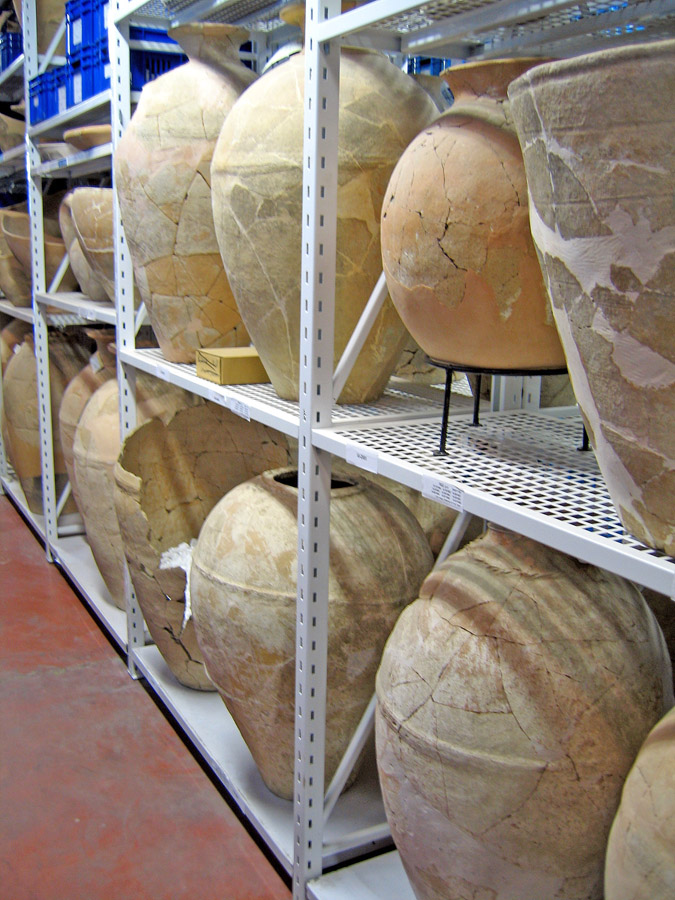
All image rights owned by Tamar
In light of stories coming out of Israel about the illicit antiquities trade, we are pleased to share a blog post by Alexia V. Ogden, a law student based in the UK.
The Israeli state enacted the Antiquities Law of 1978 to crack down on the illicit trade of antiquities. Given the nature of the Palestine-Israeli conflict, cultural heritage sites across the area have suffered extensive looting. However, dating as far back as the second century, religious pilgrims have long been attracted to the Lands of the Bible and many were encouraged by religious officials to bring back relics (Kersel 2008: 22). The search for antiquities and relics heightened during the time of the Crusades and continued throughout the Ottoman period until the present day. In response to the extensive expropriation of cultural property, the 1978 Antiquities Law declared national ownership over all archaeological material found after its enactment and banned excavation without a permit. Nevertheless, an offshoot of the law was a legalised trade in antiquities; the sale of items already on the shops’ shelves was permitted, so long as these were acquired prior to 1978.[1] This has led some to associate Israel with a “collector’s paradise” (Gopher et al 2002: 191).
During the rule of the Ottoman Empire and until 1884, the discovery of cultural patrimony functioned as follows: one third of the archaeological find went to the private landowners, the second third went to the excavator, and the last part went to the state. This resulted in Europeans buying lands and then excavating them, so that two thirds of the archaeological treasures belonged to them. The 1869 Ottoman regulation, which was re-promulgated in 1872 and comprised of only seven articles, was the first Ottoman decree concerning antiquities.[2] In the face of increasing expropriation of cultural property, the Ottoman Empire tightened regulations through the 1874 Antiquities Law, which replaced the previous law and was published in French and Turkish to ensure global understanding. This law was primarily aimed at foreign excavators and dealers and functioned more as a protection mechanism (Kersel 2008: 24).
A decade later, the Ottoman Law of 1884 established national ownership over all antiquities discovered on Ottoman soil. In addition to securing national patrimony the law also introduced regulations regarding excavation permits and taxes for the sale of antiquities. All artefacts discovered were to be sent to the Imperial Museum in Constantinople to be vetted prior to any decision. Chapter I Article 8 prohibited the export of all antiquities without the explicit consent of the Imperial Museum. However, this pushed the trade underground and established an intricate smuggling network throughout the region, which has persisted till present day (Kersel 2008: 24).
Indeed, practical enforcement of this law was difficult given the size of the empire and the insufficient number of officials to oversee the implementation of these rules. Furthermore, the law was easily circumvented through archaeological diplomacy (Pravilova 2014: 187). Ultimately, ‘state property’ meant that the antiquities were not the property of the state but of the sultan, who was able to trade for political loyalty and support (Ibid.: 187).
Following the fall of the Ottoman Empire, the British Mandate over Palestine was established by the League of Nations. The British were to be the temporary trustees of Palestine and were to ensure the protection of cultural heritage. In 1918, the government of the British Mandate declared the Antiquities Proclamation, which served to publicise the importance of cultural heritage and the need for its protection. This resulted in the archaeological sites acquiring ‘more professional and bureaucratic legal status’ rather than purely religious significance (Kersel 2008: 24). It was in this period that the Palestine Archaeological Museum was established from which the Department of Antiquities (DOA) operated.[3] John Garstang, Director of the DOA, used elements of the 1884 Ottoman Antiquities Law, to produce the 1920 Antiquity Ordinance. Similar to the Ottoman Law of 1884, it established national patrimony over all cultural property found in Palestine. Unlike the Ottoman laws, the legislation was to be overseen locally rather from the metropole. The 1920 Antiquity Ordinance defined antiquity as ‘any object or construction made by human agency earlier than A.D. 1700’ and it retracted some of the more unpopular properties of the Ottoman law, thereby legalising the sale of some material deemed duplicates of objects already in the national repository (Kersel 2008: 26). The result was a legal trade in antiquities, which was controlled by the DOA.
The 1920 Ordinance carefully regulated the trade in antiquities; dealers required a licence and their shops were to be inspected regularly. The Ordinance also introduced permits from the Department and taxes of 10% on exported antiquities. Failure to comply with the regulations was punishable as was ‘wilful or negligent destruction or defacement’ of the cultural heritage (Bentwich 1924: 253-254). The Ordinance, according to Bentwich, was successful because within four years a record of all archaeological sites and collections was completed and this enabled the foundation of a Palestine archaeological museum – “…so popular is this museum in Jerusalem that it is visited by not less than 1,000 visitors in a day. It has acquired, under the powers of the Legislature, the most notable objects, which have been unearthed in the diggings of the last four years” (Bentwich 1924: 254).
In 1929, another Antiquities Ordinance (No.51) was implemented. It forms the basis of all current legislation in Palestine and Israel and it specified the guidelines for dealing in antiquities. Dealers must apply for a license and provide an inventory list as well as submit to regular inspections by the DOA (Kersel 2008: 26). Following the establishment of Israel in 1948 and the Nakba, the 1929 Ordinance remained the primary legislation in place for cultural heritage protection. Indeed the Law and Administration Ordinance in 1948 reaffirmed the 1929 Ordinance as the primary legislation for the protection of cultural heritage. Similarly, in the West Bank the Jordanian Temporary Law no. 51 (1966) reiterated the same 1929 rules, except that the penalties for noncompliance were more severe. Since the 1967 war, the Israeli state has introduced a series of military orders in the occupied territories, which ultimately repeat the 1929 Ordinance but consign oversight to Israeli officials and not to the Palestinian Authority.[4] However, unlike the Ordinance, which required a permit for each artefact, the military orders require a ‘blanket export license’ (Kersel 2008: 28), which effectively relaxes the legislation. This could potentially provide the antiquities’ dealers in Israel with an ‘unending supply’ of artefacts (Kersel 2008: 29).[5]
The Israeli State formulated the 1978 Antiquity Law, and finally the 1989 Antiquities Authority Law, through which the Israel Antiquities Authority (IAA) was founded. This established the IAA as “the organization responsible for all the antiquities of the country, including underwater finds. The IAA is authorized to excavate, preserve, conserve and administrate antiquities when necessary.” However, despite these laws, illicitly excavated and acquired items are still being sold legally in the marketplace. This instinctively provides the incentive to loot archaeological sites. The result is that much is looted, and through a complicated process of laundering, it is resold from licensed dealers in Israel. A new law introduced in April 2012 was to eliminate these loopholes and better ‘prevent the importation … of antiquities that were stolen or plundered in other countries’ (IAA 2012). The law requires the dealers to report their inventories through an online programme, removing from the list the items sold so that identification numbers cannot be recycled for looted items. Previously, the recording of inventory was done manually and could thus be easily falsified, allowing dealers to claim that the items were acquired prior to 1978, when in reality they were looted much later. Ultimately, antiquity dealers operating in Israel have previously succeeded in exporting countless artefacts oversees and it is likely that in the near future additional cases such as the Hobby Lobby one will arise and thus the accomplishments of this new legislation remain to be seen.
Time line:
1835 Protection of Antiquities (Egypt)
1874 Antiquities Law (Ottoman Empire)
1884 Antiquities Law (Ottoman Empire)
1918 Antiquities Proclamation (British Mandate)
1920 Antiquities Ordinance (British Mandate)
1929 Antiquities Ordinance No. 51 (British Mandate)
1930 Antiquities Rules (British Mandate)
1966 Temporary Law no. 51 on Antiquities (Jordan)
1973 Military Order No. 462 (Gaza Strip)
1978 Antiquities Law (Israel)
1986 Military Order No. 1166 (The West Bank)
1989 Antiquities Law (Israel)
2012 Legislation on Antiquities Inventories (Israel)
Bibliography
Bentwich, Norman. 1924. “The Antiquities Law of Palestine.” Journal of Comparative Legislation and International Law 6(4): 251-254.
Dunkow, Izabella. 2004. “The Ephesus Excavations 1863-1874, in the Light of the Ottoman Legislation on Antiquities.” Anatolian Studies 54(1): 109-117.
Field, Les, Watkins, Joe & Gnecco, Cristobal. 2016. Challenging the Dichotomy: The Licit and the Illicit in Archaeological and Heritage Discourses. Tucson: University of Arizona Press.
Friedlander, Marty. 2016. “Can You Buy Genuine Antiquities in Israel?” January 14. Haaretz.
Gopher, A. Greenberg, R. Herzog, Z. 2002 Archaeological Public Policy Public Policy in Israel. Perspectives and Practices. New York: Lexington Books.
Israel Antiquities Authority. 2012. “Israel Antiquities Authority Inspectors Seized Two Covers of Ancient Sarcophagi that Previously Contained Egyptian Mummies and were Smuggled into Israel.” March. Israel Antiquities Authority. Available on: http://www.antiquities.org.il/article_eng.aspx?sec_id=25&subj_id=240&id=1925 [Accessed on 1 October 2017]
Kersel, Morag. 2008. “The Trade in Palestinian Antiquities.” Jerusalem Quarterly 33(1): 21-38.
Pravilova, Ekaterina. 2014. A Public Empire: Property and the Quest for the Common Good in Imperial Russia. New Jersey: Princeton University Press
[1]As Marty Friedlander (2016) warns, this naturally leads to situations in which salesmen assure the potential buyer that the antiquity has ‘been sitting on the shelf of his shop since Menachem Begin entered office’.
[2]Izabella Dunkow (2004) suggests that this interest in antiquities was provoked by the visit of Sultan Abdülaziz to Europe in 1867 and encouraged by his visit to the Abraz Gallery in Vienna. Nevertheless, it seems likely that these regulations were a direct response to the expropriation of cultural property of national importance, for example, amongst other items, the Pergamon Altar. Ekaterina Pravilova (2014) argues that the first Ottoman law on the protection of antiquities occurred in Egypt (1835) and it prohibited the export of archaeological finds and made the protection of cultural heritage and monuments a royal obligation. This arose because the Ottoman military commander Muhammad Ali Pasha, the self-declared Khedive (viceroy) of Egypt in 1805 was using cultural heritage as foreign currency. He gave antiquities as gifts so that he was able to secure favourable relations with Europe. The Khedive was not officially recognised by the Ottoman Empire until 1867.
[3]The Palestine Archaeological Museum was seized by Israel following the Six Day War (1967) and was renamed the Rockefeller Museum. It remains under the management of the Israel Museum, despite its location in East Jerusalem.
[4]For example: 1973 Military Order No. 463 in Gaza forbade the exportation of antiquities from Gaza unless explicitly permitted by the director of the DOA and 1986 Military order No. 1166, ultimately repeated the legislation of the 1929 Ordinance but authorised an Israeli antiquities staff officer for the West Bank, who would oversee the implementation of the regulations and whose approval was required to export antiquities from the region.
[5]This ambiguity was later corrected in 2002 Chapter 4 Section 20 which states that: (a) A person may not bring into Israel an antiquity from the region, unless he has received approval to do so from the Director; (b) In this paragraph, “region” includes: Judea and Samaria [The West Bank] and the Gaza Strip.
by Amineddoleh & Associates LLC | Oct 3, 2017 |
Note: All of the information in this blog post is taken from a publicly filed document. No confidential or privileged information was used in preparing this post.
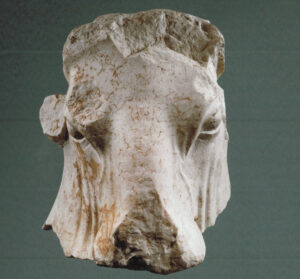 On September 22, Matthew Bogdanos submitted an application in NY Supreme Court in a matter involving a stolen antiquity from Lebanon. Our founder served as a cultural heritage law expert on this case. It was an honor to once again work with Bogdanos, a talented trial attorney. His track record for excellence is impressive, and the filing in this case is a tour de force of legal writing, reading like a suspenseful crime narrative and primer on cultural heritage law. The document was full of famous art world names, citations to landmark cases and conventions, and introduction to the world of art crime and heritage looting.
On September 22, Matthew Bogdanos submitted an application in NY Supreme Court in a matter involving a stolen antiquity from Lebanon. Our founder served as a cultural heritage law expert on this case. It was an honor to once again work with Bogdanos, a talented trial attorney. His track record for excellence is impressive, and the filing in this case is a tour de force of legal writing, reading like a suspenseful crime narrative and primer on cultural heritage law. The document was full of famous art world names, citations to landmark cases and conventions, and introduction to the world of art crime and heritage looting.
The cast of characters involved in this matter have become household names in the heritage field. The Aboutaams (owners of Phoenix Ancient Art) have been involved in numerous legal battles; Robin Symes, described as a “disgraced” art dealer, has been connected to dozens of pillaged antiquities; Frederick Schultz (former New York gallery owner and former president of the National Association of Dealers in Ancient, Oriental and Primitive Art) served time for dealing in looted Egyptian antiquities; Michael Steinhardt, founder of a hedge fund and referred to as “Wall Street’s Greatest Trader,” has faced many legal controversies for his art collection (including this year’s disputed sale of the Guennol Stargazer at Christie’s); and Frieda Tchacos, a dealer with a history of antiquities violations has been profiled for her role in the illicit antiquities trade. All of these individuals have been featured in books like Chasing Aphrodite and the Medici Conspiracy. In fact, the dispute over the Bull’s Head reads like a redux of the Euphronios Krater debacle at the Metropolitan Museum of Art (“the Met”). However, as Bogdanos notes in the government’s filing, the Met acted “admirably” by removing the item from display and delving into the object’s past.
The current controversy involves an antiquity that was purportedly looted from storage in Lebanon during the nation’s civil war. It went missing for decades and then appeared at the Met after it was loaned to the museum by Michael Steinhardt. He had purchased the item from wealthy collectors, Will and Lynda Beierwaltes. Once Steinhardt was informed of the work’s problematic provenance, he demanded a refund for the purchase and transferred title to the object back to the couple.
One of the most interesting aspects of this case is Bogdanos’ discussion about “good faith.” The Beierwaltes are not novice collectors; they owned a collection of antiquities valued at nearly $100 million. As “professional” collectors, did they really use good faith in acquiring the antiquity? As Bogdanos rightly asks: where are the documents related to the object? If an antiquity of such high value (over a million dollars) crosses international borders multiple times, there should be documentation that traces its movements.
“There is no customs declaration form, no shipping document, no air waybill, no tracking form, no insurance form, no invoice, no bill of sale, no photograph, and no mention in any contemporaneous correspondence or email. No proof of any kind of the possession and repeated transportation across oceans and international borders of a two-millennia-old statue valued at more than one million dollars by either of the names listed by the Met on October 20, 2017.” As stated on page 45, “…twenty-four years (1981-2004) of movement across international borders of a million-dollar statue generated four handwritten words, a couple storage invoices, and one piece of paper from the infamous Robin Symes. A neon sign flashing ‘stolen’ would have been more subtle and less insidious.”
One of the disturbing aspects of this controversy is the allegation that the sculpture was taken during the civil war in Lebanon. If true, then the item was pilfered by opportunists taking advantage of political upheaval to steal priceless and irreplaceable treasures. Sadly, this type of theft occurs around the world and is still common today, particularly prevalent in Syria and Iraq.
Purchasing items without complete provenance is risky. As I explained in this editorial in The Guardian, looted antiquities are problematic from an investment perspective. Bogdanos warns against this risk, stating “The obvious, but all-too-often ignored, risks attendant to never asking about ownership history is that the buyer may one day have that purchase seized and confiscated as stolen property. Here, the absence of the required inquiry, not only subjects the Beierwaltes to potential prosecution for criminal possession of stolen property, but it also defeats any claim that they were good-faith purchasers of the Bull’s Head.”
As outlined in the government’s conclusion, there are a host of important facts to recognize in this case. (1) The Bull’s Head was excavated in 1967 and stolen in 1981 during a civil war, nearly 50 years after Lebanon’s patrimony laws (the laws vest ownership of all discovered antiquities in the nation). (2) The sculpture surfaced in the hands of Robin Symes in NY in early 1996. As revealed by several international investigations, Symes was a major participant in an antiquities trafficking network in the 1980s and 1990s. The network’s black-market supply chain started with tomb raiders, passed through the launderers and middle men, and terminated at the demand end with collectors, like the Beierwaltes. (3) The Symes-Beierwaltes relationship was responsible for 98% of the vast Beierwaltes Collection, valued at almost $100 million in 2006. The acquisition of the collection appears to have coincided with the peak of the Medici, Becchina, and Symes empire of loot. (4) There is a shocking lack of documentation produced by the Beierwaltes. (5) The lack of records is especially telling for collectors involved in the art trade for 62 years. (6) The Beierwaltes avoided submission of any materials pursuant to discovery requests, despite multiple subpoenas and repeated requests. There is also no evidence concerning how Robin Symes acquired the Bull’s Head or whether he legally possessed it. (7) Lebanon made commendable efforts to protect and to recover its cultural heritage.
A copy of the the government’s filing can be found on the Chasing Aphrodite website: https://chasingaphrodite.com/2017/09/24/the-sidon-bulls-head-court-record-documents-a-journey-through-the-illicit-antiquities-trade/
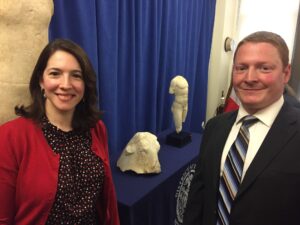
Our founder at the repatriation ceremony in 2017
UPDATE: The Bull’s Head (as well as two other pieces) were returned to Lebanon in December 2017.


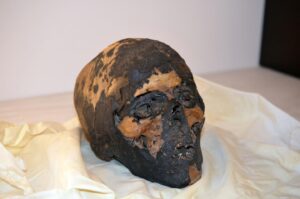 The new year is off to a great start with another international repatriation. Later this month, fragments of a mummy will be returned to the Arab Republic of Egypt. The skull and two dismembered hands were taken from Egypt in the 1920s in violation of the nation’s antiquities laws. Leila Amineddoleh served as the cultural heritage law expert for the government.
The new year is off to a great start with another international repatriation. Later this month, fragments of a mummy will be returned to the Arab Republic of Egypt. The skull and two dismembered hands were taken from Egypt in the 1920s in violation of the nation’s antiquities laws. Leila Amineddoleh served as the cultural heritage law expert for the government.





 On September 22, Matthew Bogdanos submitted an application in NY Supreme Court in a matter involving a stolen antiquity from Lebanon. Our founder served as a cultural heritage law expert on this case. It was an honor to once again work with Bogdanos, a talented trial attorney. His track record for excellence is impressive, and the filing in this case is a tour de force of legal writing, reading like a suspenseful crime narrative and primer on cultural heritage law. The document was full of famous art world names, citations to landmark cases and conventions, and introduction to the world of art crime and heritage looting.
On September 22, Matthew Bogdanos submitted an application in NY Supreme Court in a matter involving a stolen antiquity from Lebanon. Our founder served as a cultural heritage law expert on this case. It was an honor to once again work with Bogdanos, a talented trial attorney. His track record for excellence is impressive, and the filing in this case is a tour de force of legal writing, reading like a suspenseful crime narrative and primer on cultural heritage law. The document was full of famous art world names, citations to landmark cases and conventions, and introduction to the world of art crime and heritage looting.